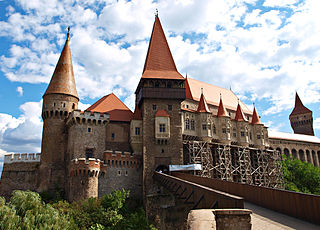
Hunedoara is a city in Hunedoara County, Transylvania, Romania. It is located in southwestern Transylvania near the Poiana Ruscă Mountains, and administers five villages: Boș (Bós), Groș (Grós), Hășdat, Peștișu Mare (Alpestes), and Răcăștia (Rákosd).

Komárno, colloquially also called Révkomárom, Öregkomárom, Észak-Komárom in Hungarian, is a town in Slovakia at the confluence of the Danube and the Váh rivers. Historically it was formed by the "old town" on the left bank of Danube, present day Komárno in Slovakia, and by a "new town" on the right bank, present day Komárom in Hungary, which were historically one administrative unit. Following World War I and the Treaty of Trianon, the border of the newly created Czechoslovakia cut the historical, unified town in half, creating two new independent towns in two countries. Komárno and Komárom are connected by the Elisabeth Bridge, which used to be an official border crossing between Slovakia and Hungary until border checks were lifted due to the Schengen Area rules. In 2020, a new road bridge was opened.
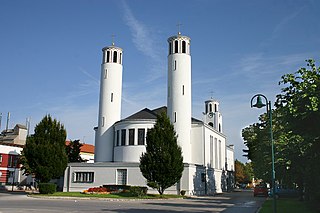
Andau, is a village in Burgenland, Austria, near the border of Hungary. It is situated in the flat, lake-studded Seewinkel region which is part of the Little Hungarian Plain.
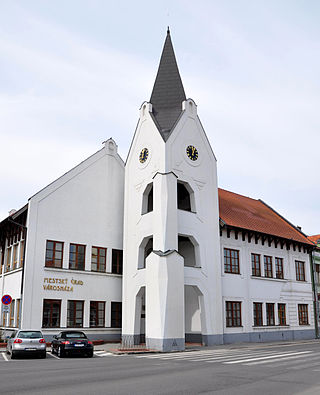
Dunajská Streda (Slovak pronunciation:[ˈdunajskaːˈstreda] ; Hungarian: Dunaszerdahely; German: Niedermarkt; is a town located in southern Slovakia. Dunajská Streda is the most culturally significant town in the Žitný ostrov area. The town has a population of 22,730, with ethnic Hungarians forming the 72% majority.

Bácsalmás is a small town in southern Hungary in the region of Bácska close to the border with the Vojvodina region of Serbia, with a population of 7,694 people.
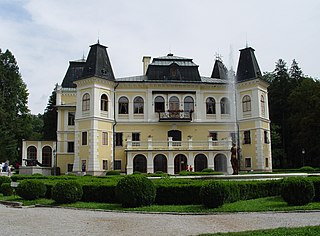
Betliar is a village and municipality in the Rožňava District in the Košice Region of eastern Slovakia, known for its manor house.
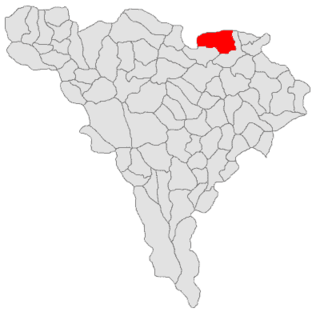
Unirea, previously Vințu de Sus, is a commune located in the north-east of Alba County, Transylvania, Romania. It is composed of six villages: Ciugudu de Jos (Alfüged), Ciugudu de Sus (Felfüged), Dumbrava (Dombró), Inoc (Inakfalva), Măhăceni (Aranyosmohács) and Unirea.

Maťovské Vojkovce is a village and municipality in Michalovce District in the Košice Region of eastern Slovakia. Mayor of the village is Lýdia Czapová
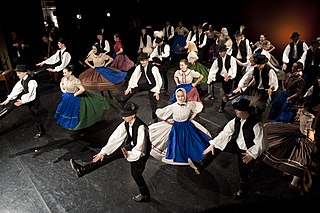
Hungarian dance refers to the folk dances practised and performed by the Hungarians, both amongst the populations native to Hungary and its neighbours, and also amongst the Hungarian diaspora.
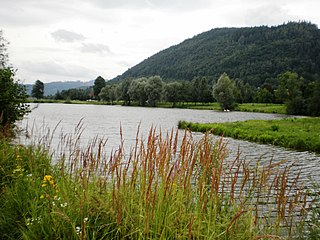
Divinka is a village and municipality in Žilina District in the Žilina Region of northern Slovakia.

Vállaj is a village in Szabolcs-Szatmár-Bereg county, in the Northern Great Plain region of eastern Hungary. Vállaj is a settlement in the south-eastern corner of Szabolcs-Szatmár-Bereg county, by the Kraszna river, next to the Hungarian-Romanian border.

Tiszamogyorós is a village in Szabolcs-Szatmár-Bereg county, in the Northern Great Plain region of eastern Hungary. East of Mándok, no. Tiszamogyorós is located in the North of Nyírség, in a landscape called Tiszamogyorós. The village, which suffered a lot from the floods of the Tisza, moved to its current fourth place in 1864.
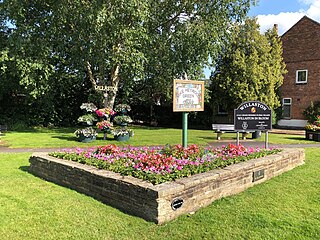
Willaston is a civil parish and village in the unitary authority of Cheshire East and the ceremonial county of Cheshire, in north-west England. It had a population of 3,104 at the time of the 2011 census, up from 2,973 in 2001.

Veszprémgalsa is the village of Galsa in Veszprém county, in the district of Sümeg. Prior to 1969 it was referred to as Galsa or Zalagalsa, Zala being the former county affiliation. However, in 1969 the villages of Veszprémpinkóc and Zalagalsa were combined creating Veszprémgalsa.

Balatonföldvár is a popular resort town in Somogy County, Hungary, on the southern side of Lake Balaton, approximately 120 km southwest from Budapest and about 23 km southwest from Siófok, the "capital of Balaton". Balatonföldvár is a frequently visited tourist destination among Hungarians and foreign guests because of its natural beauties, historical heritages or its countless leisure opportunities. The town offer several water sport and mainland sport activities.

Zsujta is a village in Borsod-Abaúj-Zemplén county, Hungary. A large Bronze Age hoard of weapons and cart fittings, was discovered at the village in the late 19th century. The hoard is now in the collections of the British Museum, London.

Hács is a village in Somogy county, Hungary.

Vízvár is a village in Somogy County, Hungary. Zsitvapuszta and Csütörtökhely are parts of the settlement.

Ostffyasszonyfa is a village in Vas county, Hungary. The village was first recorded in 1346 under the name Azzunfalva. By then it was already an important ferry point on the River Rába, and in later centuries also gained military strategic importance. Wooden bridges were constructed here, which were replaced by an iron bridge in the 19th century. The iron bridge was destroyed during World War II and the present bridge was built in the late 1960s.

Karancsalja is a village in Nógrád county, Hungary, in Salgótarján District.























